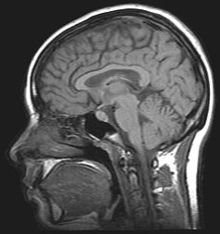
Back فرط الضغط داخل القحف مجهول السبب Arabic Унутрычарапная гіпертэнзія Byelorussian Hipertensió intracranial idiopàtica Catalan Idiopathische intrakranielle Hypertension German Ιδιοπαθής ενδοκρανιακή υπέρταση Greek Pseudotumor cerebral Spanish Hypertension intracrânienne idiopathique French יתר לחץ תוך-גולגולתי עצמוני HE Hipertensi intrakranial idiopatik ID Ipertensione endocranica Italian
| Idiopathic intracranial hypertension | |
|---|---|
| Other names | Benign intracranial hypertension (BIH),[1] pseudotumor cerebri (PTC)[2] |
 | |
| For the diagnosis, brain scans (such as MRI) should be done to rule out other potential causes. | |
| Specialty | Neurology |
| Symptoms | Headache, vision problems, ringing in the ears with the heartbeat[1][2] |
| Complications | Vision loss[2] |
| Usual onset | 20–50 years old[2] |
| Risk factors | Hypervitaminosis A, obesity, tetracyclines[1][2] |
| Diagnostic method | Based on symptoms, lumbar puncture, brain imaging[1][2] |
| Differential diagnosis | Brain tumor, arachnoiditis, meningitis[3] |
| Treatment | Healthy diet, salt restriction, exercise, surgery[2] |
| Medication | Acetazolamide[2] |
| Prognosis | Variable[2] |
| Frequency | 2 per 100,000 per year[4] |
Idiopathic intracranial hypertension (IIH), previously known as pseudotumor cerebri and benign intracranial hypertension, is a condition characterized by increased intracranial pressure (pressure around the brain) without a detectable cause.[2] The main symptoms are headache, vision problems, ringing in the ears, and shoulder pain.[1][2] Complications may include vision loss.[2]
This condition is idiopathic, meaning there is no known cause. Risk factors include being overweight or a recent increase in weight.[1] Tetracycline may also trigger the condition.[2] The diagnosis is based on symptoms and a high opening pressure found during a lumbar puncture with no specific cause found on a brain scan.[1][2]
Treatment includes a healthy diet, salt restriction, and exercise.[2] The medication acetazolamide may also be used along with the above measures.[2] A small percentage of people may require surgery to relieve the pressure.[2]
About 2 per 100,000 people are newly affected per year.[4] The condition most commonly affects women aged 20–50.[2] Women are affected about 20 times more often than men.[2] The condition was first described in 1897.[1]
- ^ a b c d e f g h Wall, M (February 2017). "Update on Idiopathic Intracranial Hypertension". Neurologic Clinics. 35 (1): 45–57. doi:10.1016/j.ncl.2016.08.004. PMC 5125521. PMID 27886895.
- ^ a b c d e f g h i j k l m n o p q r s "Idiopathic Intracranial Hypertension". National Eye Institute. April 2014. Archived from the original on 8 July 2019. Retrieved 8 November 2017.
- ^ "Idiopathic Intracranial Hypertension". NORD (National Organization for Rare Disorders). 2015. Retrieved 8 November 2017.
- ^ a b Wakerley, BR; Tan, MH; Ting, EY (March 2015). "Idiopathic intracranial hypertension". Cephalalgia: An International Journal of Headache. 35 (3): 248–61. doi:10.1177/0333102414534329. PMID 24847166. S2CID 28592337.
© MMXXIII Rich X Search. We shall prevail. All rights reserved. Rich X Search